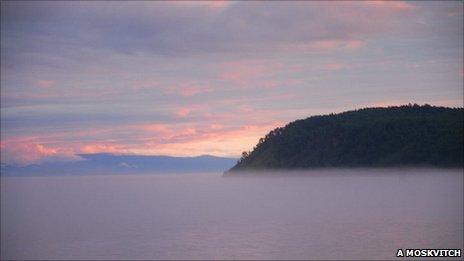Underwater telescope searches for space secrets
- Published
Bair Shaibonov explains his work with the NT-200 underwater telescope in Lake Baikal
It is one of the most unusual telescopes on the planet.
Floating just over 1km below the surface of the world's deepest lake - Baikal in central Russia - the NT-200 telescope points not at the sky but towards the centre of the Earth.
Its designers are not interested in observing the fish or other lifeforms that inhabit the lake.
The telescope was built to capture an elusive fundamental particle called the neutrino, in a bid to unravel the secrets of how the Universe formed.
Neutrinos have no electric charge and interact very weakly with other forms of matter.
So much so that they are able to pass straight through the Earth without hitting anything. This has led some to dub them "ghost particles".
High-energy neutrinos originate in supernovae (stellar explosions), so-called active galactic centres, huge cosmic blasts known as gamma-ray bursts and neutron stars. They are extremely difficult to detect and, until now, there has only been indirect evidence of their existence.

Computer artwork of a neutrino telescope detecting Cherenkov radiation (blue light)
But Russian physicists working in Siberia are planning to upgrade their underwater telescope, aiming to "catch" a high-energy neutrino from beyond the Solar System. If they succeed, this would be the first detection of such a particle.
Neutrinos can also be produced when cosmic rays from outer space hit the Earth's atmosphere.
But it is vital to screen out these low-energy atmospheric neutrinos produced by the cosmic rays, so that sensitive instruments like the NT-200 can home in on the high-energy neutrinos scientists are interested in.
For that to happen, the telescope has to be in as dark and deep a place as possible.
More than a kilometre of water in Baikal's clear abyss turned out to be a perfect solution, effectively preventing the majority of low-energy particles from reaching the detector.
"There are different carriers of information about the Universe, and the [high-energy] neutrino is one of them," Nikolai Budnev, the director of the Applied Physics Institute of the Irkutsk State University, told BBC News.
Dr Budnev's university operates the telescope in collaboration with several other institutes.

The Circum-Baikal Railway was built under the tsarist rule between the late 19th and early 20th Centuries
NT-200 has yet to capture high-energy neutrinos from outer space, but the Russian scientists say that by registering close to 400 low-energy atmospheric neutrinos each year, they have shown that the technique is ready to be used for more challenging endeavours once the telescope has been upgraded.
The research could shed light on a number of interesting phenomena in the Universe.
The Baikal neutrino detector in Siberia was the first of its kind, built in 1993. It made the first ever detection of an atmospheric neutrino in 1994 and started working at full power in 1998.

The telescope is monitored from the control room - a wooden house on the shore
Only two similar experiments exist - the Antares instrument, located 2.5km under the Mediterranean Sea, and the Antarctic Muon and Neutrino Detector Array (Amanda) which is stationed in the ice at the South Pole. But several other projects are underway, such as the Ice Cube Neutrino Observatory, also at the South Pole.
With arrays of photomultiplier tubes, the Baikal telescope resembles an octopus. Underwater, the structure of 192 glass "balls" spans 42m in length and 70m in height.
The tubes detect neutrinos by registering the intensity of Cherenkov light - electromagnetic radiation emitted when a charged particle passes through a medium, for example, water or air, at great speed.
The scientists who manage NT-200 say that the location of their machine presents numerous advantages.

The scientists say Baikal lake is an "ideal" location for an underwater telescope
"It is in a unique lake - there are no similar conditions to Baikal's anywhere else on Earth," said Bair Shaibonov, an astrophysicist who was on a shift at the NT-200 base.
Mr Shaibonov, from the Joint Institute of Nuclear Research in Dubna, added: "There is a lot less chance of a storm compared to a sea or an ocean, and since the water here is fresh and not saline, the equipment does not get rusty for years. And ice in the winter creates a perfect natural platform for upgrades and repairs."
Getting to the telescope's control room on Baikal's northern shore is rather tricky.
There are no roads going there. One can get to the site and to nearby villages either on a private motorboat or by train using the Circum-Baikal Railway.
The train comes only once a day and runs through a multitude of tunnels on a single railway track.
Every March, when the lake is deep-frozen, the annual update and repair procedures of the telescope take place.
Physicists move on to the thick Baikal ice, together with cabins and some machinery.
"When I first got on to the ice, I had some unforgettable feelings. You know that the ice under your feet is a rather fragile surface and you just can't feel very comfortable right away," Mr Shaibonov recalled.
Oleg Gress on the unusual Tunka-133 telescope
"Sometimes the ice cracks. The sound of it cracking is extremely loud and you instinctively think where to jump to avoid falling into the water, but that never happened."
Throughout the year, physicists monitor the device from a control room in a small wooden house on Baikal's coast.
There is no running water there and a wooden toilet is outside. To stay warm during long, brutal winters when the temperatures drop to -35C, researchers use a self-made heater and chopped wood.

Oleg Gress is one of the scientists at the Tunka-133 site
Now physicists are hoping that the Russian Ministry of Sciences and Education will provide them with financial assistance to upgrade the telescope and also improve the living conditions for those working on the site.
Dr Budnev said that they had recently applied for a government grant and were hoping to get a positive response.
The main goal is getting enough money to replace the current telescope with a more modern one of around a cubic kilometre in volume.
But the NT-200 is not the only experiment of this kind in the area. Another detector nearby, called Tunka-133, studies the energy and mass of cosmic rays - the sources of atmospheric neutrinos.
Tunka-133
This experiment comprises 133 metal canisters, scattered on a flat, endless field not far from Baikal.
In order to register the cosmic rays, this telescope's multiple lenses are oriented towards the sky, with the canisters opening simultaneously at night.
Cosmic rays consist of sub-atomic particles with very high energies.
Scientists know that they come from the most remote corners of the Universe, but their exact nature and origin remain a mystery.
Tunka-133 is one of the mechanisms devised to hunt for clues.
The telescope does so by means of measuring cosmic ray air-showers - the cascades of high-energy charged particles produced when cosmic rays pierce our planet's atmosphere and collide with other atoms.
Oleg Gress, one of the scientists working on Tunka-133, said that it could get lonely at the remote site. Sometimes, the local Buryat people arrive on horseback to sit at the fire and sing songs.

Tunka-133 telescope is located in the Buryat republic, on a remote field
But he said the work he was doing was rewarding, and the experimental base was unique.
"We are able to register the exact moment when cosmic ray shower begins, within five nanoseconds - it's simply incredible. We can also determine the energy of the particles and their nature," he said.
"But the main goal is [to eventually detect] ultra-high-energy particles that are accelerated in major cosmic events, such as supernovae."
Just like at the base of the underwater neutrino detector, living conditions at the Tunka-133 site are far from ideal.
But Mr Gress says that the goal of making exciting new discoveries about our Universe often makes him forget about personal discomfort.

The scientists say they enjoy working in such a remote location
- Published23 July 2010
- Published29 July 2010
- Published22 June 2010